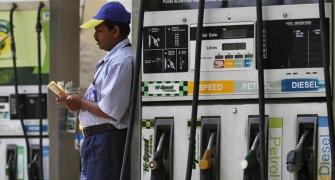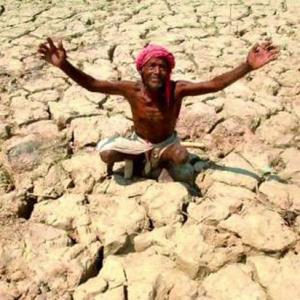The total quantum of water supply has barely improved since Independence, while demand has exploded, points out T N Ninan.

For those who seek nationalism through slogans, reality has called for attention. Punjab has defied the Supreme Court and acted to deny river water to Haryana (water that it gets from upstream Himachal Pradesh).
The good citizens of Haryana acted likewise recently, to cut off Yamuna water supply to Delhi through the Munak canal; the army had to move in. A crisis-ridden capital had to shut down schools and take other emergency measures.
Meanwhile, the Marathwada region is so short of drinking water that there is the danger of widespread unrest; the civil administration has decreed that no assembly can be of more than four people near any point of water supply.
Further south, Telangana and Andhra Pradesh squabble over the sharing of river waters - adding one more river water dispute to the total. This is about Bharat Mata ki jal - not jai.

|
Balancing supply and demand can be done through greater tapping of river flows, changing cropping patterns, pricing water correctly improving the dismal management of urban water systems and adopting technologies that reduce water use in homes. |
Water shortages have been growing each year, and the groundwater table has fallen steadily from over-drawing. You can continue to do that, like drawing down a bank balance - if you ignore the fact that drilling ever deeper wells raises farming costs. But once the balance is close to exhaustion, the crisis comes very quickly.
Already, many millions in different parts of the country have been joining the ranks of the water- distressed each year, because nothing is done to equate demand with the sustainable supply of water. Supply is threatened as river systems have been affected by deforestation in their catchment areas - the water run-off increases in the monsoons, thereby reducing flows in the long dry months.
The melting of Himalayan glaciers poses another threat. Demand for water has grown as the most water-intensive crops have been encouraged in water-scarce areas. Farmers have been committing suicide when wells run dry and they become unable to repay loans. While 80 per cent of water use is for agriculture, the country’s steady urbanisation has meant growing demand in towns and cities, since water consumption per head is greater in homes with running water and flush toilets.
If surface water supply were improved, through greater tapping of river waters that run to the sea or into Pakistan, the use of groundwater would come down. But large dams have become non-starters for all practical purposes; the abysmal record on rehabilitating hapless people displaced by dam projects has created a noisy activist backlash, while increased silting raises questions about the longevity of large dams.

|
If Israel, in a desert, can manage to find enough and more water for everyone’s needs (swimming pools included), India should be able to do the same. When that is done, everyone can shout “Bharat Mata ki jai |
Evening out river flows through the linking of rivers in the same large water basin has made little progress, other than in a couple of isolated cases. The spread of drip-irrigation systems (which allow sparing use of water) is minimal, because under-pricing of water skews the economics.
River water disputes have been sought to be settled through the courts and by setting up tribunals. But it is wishful thinking to believe that legalistic solutions can be found to existential disputes. The proposed technicality of transferring the ownership of river water from states to the Union similarly skirts the real issue, which is to restore the balance between supply and demand.
The hard fact is that the total quantum of water supply has barely improved since Independence, while demand has exploded. Balancing supply and demand can be done through greater tapping of river flows, changing cropping patterns, pricing water correctly, improving the dismal management of urban water systems and adopting technologies that reduce water use in homes.
The country can also push for water recycling, and turn to de-salination (there is only one plant of worthwhile size in the whole country). If Israel, in a desert, can manage to find enough and more water for everyone’s needs (swimming pools included), India should be able to do the same. When that is done, everyone can shout “Bharat Mata ki jai” or whatever slogan has caught the moment’s fancy. Till then, we need to focus on real issues and pressing problems, not manufactured controversies.










